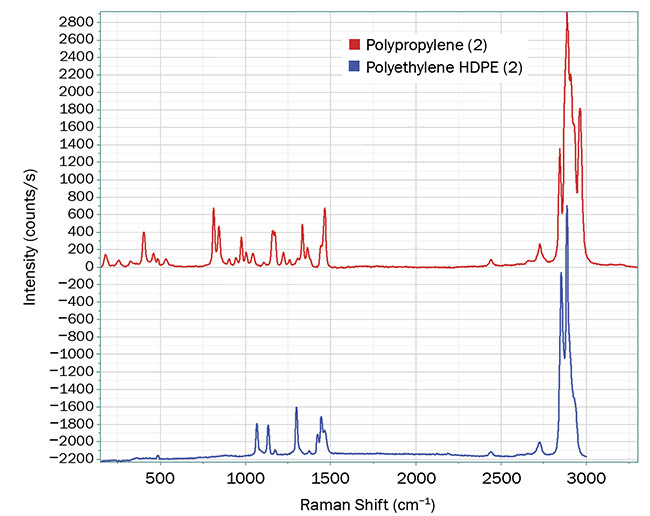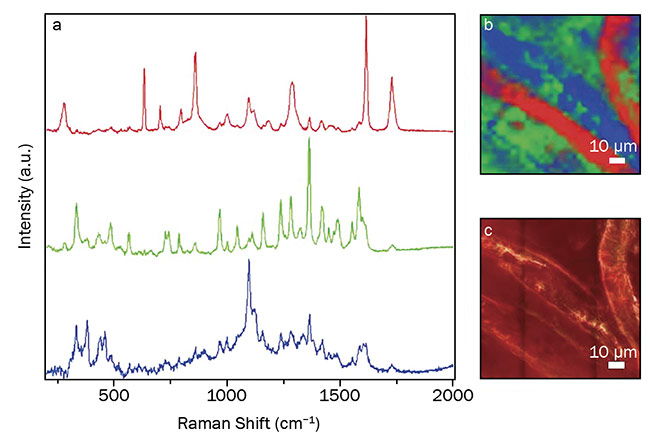
Characterizing Microplastics with Raman Spectroscopy
As the need to manage plastic waste increases, researchers are using Raman spectroscopy to characterize the toxicity of polymers and identify their sources.
HOWARD FRANK, HORIBA SCIENTIFIC
We live in a disposable world. Plastic throwaway utensils and packaging litter our landfills and often end up in our oceans.
The large pieces pose problems for aquatic life. Mistaking litter for food, sea
life eat it, which wreaks havoc on the their digestive systems and starves them of real food1. Plastics not ingested are exposed to the atmosphere, sun, and water and eventually break down into tiny pieces. These tiny pieces, when they measure 5 mm or less, are called microplastics. Microplastics also exist in the form of microbeads used — until recently — as abrasives in cosmetics and sunscreens. (This form of microplastic was recently outlawed in the U.S. by the Microbead-Free Waters Act of 2015, prohibiting the manufacturing, packaging, and distribution of rinse-off cosmetics containing these tiny plastic beads2.)

Researchers have found microplastics not only in marine environments but also in rivers, lakes, and even ice, as confirmed in a 2018 study of artic sea ice3. The long life cycles of these materials make them difficult to manage and potentially harmful. A foam cup, for example, may take up to 50 years to decompose in a landfill, and a monofilament fishing line may take 600 years4.
Plastics accumulate various contaminants and are known to collect and act as conduits for the transport of bacteria, viruses, chemicals, and harmful algae. Because the plastic materials have different levels of toxicity, accurate characterization of the materials is very important5.
Several technologies exist for characterizing microplastics, including pyrolysis gas chromatography/mass spectrometry, Fourier transform infrared spectroscopy (FTIR), and Raman spectroscopy. Raman spectroscopy is a proven and effective means for identifying microplastics. It has been used to study microplastics since at least the mid-1980s, with recent technological advancements such as greater sensitivity increasing its ease of use for polymer characterization.
Raman microscopy combines Raman spectroscopy and optical microscopy, and is one of the most efficient and effective
ways to identify polymers. It allows researchers to analyze microscopic pieces of plastics by focusing a laser beam onto a small spot to obtain Raman spectra.
Raman spectroscopy can probe microplastics down to the submicron size range and characterizes them by probing different vibrational modes in the molecule. Each polymer has a distinct, unique set
of vibrational modes that researchers
can use for chemical identification. If a microplastic comprises a mixture of components, Raman spectroscopy can chemically identify the polymer as well
as any additives, including pigments.
A Raman spectrometer produces a Raman spectrum, which has units of relative wave number shift (cm−1) on the X axis and intensity on the Y axis. Quantized vibrational modes within the molecule have different energies, leading to peaks in the Raman spectrum that can span anywhere from 0 cm−1 to 4000 cm−1.
Raman spectroscopy can, for example, differentiate between type 5 (polypropylene) and type 2 (high-density polyethylene) plastics (Figure 1).

Figure 1. Raman spectra show a clear difference between two samples, with polypropylene in red and polyethylene HDPE in blue. Courtesy of HORIBA Scientific.
In a separate study conducted by HORIBA Scientific researchers in its Piscataway, N.J., labs, the scientists were able to characterize microplastic fibers in fabric samples using Raman spectroscopy (Figure 2).

Figure 2. Researchers at HORIBA Scientific used 785-nm excitation to do a line-scan measurement across a fiber located in a sample labeled 100% cotton. The experiment confirmed the presence of polyethylene terephthalate (PET), a synthetic fabric in the sample. Courtesy of HORIBA Scientific.
Raman spectroscopy is also used by researchers to identify additives like pigments and dyes. The spatial selectivity that Raman microscopy offers allows them to characterize heterogeneous samples they might otherwise misidentify or mischaracterize using macroscopic techniques. By identifying vibrational modes, determination of the chemical structure of each molecule can be made.
Scientists will also frequently search polymer databases to help identify micro-plastics. In these cases, researchers compare an unknown spectrum with a reference spectrum from a database.
Once the molecules are identified, source and toxicity become easier to determine, which can then lead to contamination reduction strategies designed and implemented by companies themselves, by external regulatory bodies, or by community or consumer activists.
Experts estimate humans consume microplastics in the range of 74,000 to 121,000 particles per year through ingestion and inhalation6. The health effects of this consumption on humans are still unknown.
Meet the author
Howard Frank writes for HORIBA Scientific in Piscataway, N.J. He has an MBA and has worked in corporate management.
References
1. Alejandra Borunda (March 2019). This young whale died with 88 pounds of plastic in its stomach. National Geographic,
www.nationalgeographic.com/environment/2019/03/whale-dies-88-pounds-plastic-philippines.
2. FDA (2015). The Microbead-Free Waters Act: FAQs, www.fda.gov/cosmetics/cosmetics-laws-regulations/microbead-free-waters-act-faqs.
3. I. Peeken et al. (April 2018). Arctic sea ice is an important temporal sink and means of transport for microplastic. Nat Commun, Vol. 9, Article no. 1505, www.nature.com/articles/s41467-018-03825-5.
4. R. LeBlanc (June 2019). The decomposition of waste in landfills: a story of time and
materials. The Balance, Small Business, www.thebalancesmb.com/how-long-does-it-take-garbage-to-decompose-2878033.
5. Excerpted from a 2019 interview conducted by author with Ashok Despande, Ph.D.,
a research chemist with the Northeast
Fisheries Science Center of National Oceanic and Atmospheric Administration (NOAA) in Sandy Hook, N.J.
6. K.D. Cox (2019). Human consumption of microplastics. Environ Sci Technol., Vol. 53, Issue 12, pp. 7068-7074, https://pubs.acs.org/doi/10.1021/acs.est.9b01517.
/Buyers_Guide/HORIBA/c6267
Published: September 2019
Glossary
- raman spectroscopy
- Raman spectroscopy is a technique used in analytical chemistry and physics to study vibrational, rotational, and other low-frequency modes in a system. Named after the Indian physicist Sir C.V. Raman who discovered the phenomenon in 1928, Raman spectroscopy provides information about molecular vibrations by measuring the inelastic scattering of monochromatic light.
Here is a breakdown of the process:
Incident light: A monochromatic (single wavelength) light, usually from a laser, is...
- mass spectrometry
- Mass spectrometry (MS) is an analytical technique used to determine the molecular composition and structure of compounds based on their mass-to-charge ratio (m/z). It involves ionizing chemical substances to generate ions, separating these ions based on their mass-to-charge ratio using electric and magnetic fields, and detecting and quantifying these ions to create a mass spectrum.
Ionization: Samples are ionized using techniques such as electron impact ionization, electrospray ionization...
microplasticsplasticsRaman spectroscopypyrolysis gas chromatographymass spectrometryFourier transform infrared spectroscopyFTIRFeatures